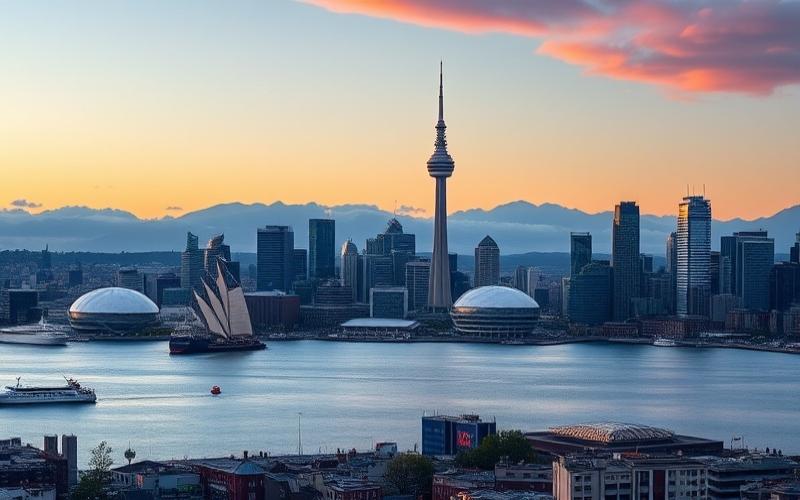
 Published on and written by Cyril Jarnias
Published on and written by Cyril Jarnias
New Zealand’s Real Estate Market: An Ever-Changing Landscape
New Zealand’s real estate market is experiencing fascinating fluctuations, capturing the attention of both investors and individuals looking to purchase property. With a rapidly evolving economy, current trends present a complex mosaic of opportunities and challenges.
Regional Price Dynamics
House prices are skyrocketing in certain key regions, while other areas are becoming attractive in terms of affordability.
The Influence of Environmental Factors
Environmental factors, such as sustainability policies and the impact of climate change, are playing an increasingly significant role in the decisions of buyers and builders.
Good to Know:
To better understand these complex dynamics and their impact on the future of real estate in New Zealand, this article offers a deep dive into the emerging trends shaping this intriguing market.
Booming Sectors in the New Zealand Real Estate Market
New Zealand regions with strong real estate growth primarily include Southland (+17.7% year-over-year), Gisborne (+13.4%), Northland (+8.1%), Otago (+8.1%), and Hawke’s Bay (+5.1%). Other sectors like Bay of Plenty (2.8%), Manawatu/Whanganui (2.6%), Taranaki (1.7%), and Nelson (1.2%) are also showing moderate increases. In contrast, major regions such as Auckland or Wellington are experiencing a correction with falling or stagnant prices.
The reasons for this rapid growth are multiple:
- Local economic development: these regions benefit from infrastructure investments and increased economic activity.
- Demographic appeal: financial affordability attracts new residents and investors.
- Improved transportation or public services that enhance residential attractiveness.
Highly Sought-After Property Types:
- Affordable residential housing in secondary areas where demand is driven by the search for better value for money.
- Single-family homes in suburbs or small towns near emerging economic hubs.
- Commercial properties in anticipation of the commercial sector rebound expected in 2025 due to macroeconomic stabilization.
Comparative Table of Annual Price Increases by Region:
| Region | Annual Increase (%) |
|---|---|
| Southland | 17.7 |
| Gisborne | 13.4 |
| Northland | 8.1 |
| Otago | 8.1 |
| Hawke’s Bay | 5.1 |
Recent Statistics:
- Over half of New Zealand neighborhoods saw their property values stabilize or increase in the first quarter of 2025.
- Some affordable areas even show +6% for the quarter for certain single-family homes.
- Overall sales volumes are expected to grow by 10 to 15% in 2025 due to recent drops in mortgage rates and renewed buyer interest.
Economic/Political Factors Influencing the Future:
- Future evolution dependent on maintaining low mortgage rates favoring access to real estate credit
- Political stability encouraging domestic and international investments
- Potential reforms around sustainable housing likely to steer part of the market toward eco-friendly projects
Key Takeaway
Regional sectors offering financial affordability combined with dynamic local development remain the main current driver of the New Zealand real estate market. However, the expected favorable evolution relies on the international macroeconomic context as well as the national capacity to maintain its incentive policies to attract both residents and institutional investors.
Good to Know:
Auckland and Wellington stand out as high-growth regions in the New Zealand real estate market, thanks to their sustained economic development and improved infrastructure such as transportation and public services. Residential housing, particularly modern urban apartments and suburban homes, are especially sought after due to demographic influx. Sustainable development projects are also gaining popularity, meeting a growing demand for eco-friendly solutions. According to recent statistics, property prices in Auckland increased by 12% over the past year, while Wellington recorded a 10% rise in transaction volume. The central bank’s monetary policy and tax incentives for green investments could continue to positively influence this dynamic market.
Real Estate Price Fluctuations in New Zealand
Real estate prices in New Zealand have experienced significant fluctuations in recent years, with marked variations depending on regions and property types.
| Property Type | Median Price (NZD/m²) |
|---|---|
| Apartment | 14,127 |
| Single-Family Home (Urban) | ~13,000–15,000 |
| Rural Areas | Below National Average |
Main Recent Trends
- After a historic peak (+28.4% year-over-year in November 2021), the market experienced a significant correction reaching -13.7% in May 2023.
- In February and April 2025, the house price index declined further (-1.4% then -1.3% year-over-year).
- Outlook for late 2025 points to recovery: expected increase of about +5% in the national average price and anticipated rise in transaction volume (+10 to +15%) thanks to the gradual return of buyer confidence.
Influential Economic Factors
- The gradual decline in mortgage rates supports activity. It makes credit more accessible but does not completely eliminate financial accessibility constraints for first-time buyers.
- Supply has strengthened since the pandemic: greater abundance in certain urban areas explains localized downward pressure on some segments.
- However, the slowdown in the job market limits overall purchasing power and hinders a rapid recovery.
- The international context remains uncertain: global geopolitical tensions and economic volatility weigh on attractiveness for some foreign investors.
Recent Government Policies
- Imminent introduction of DTI caps (debt-to-income ratio), limiting the amount that can be borrowed relative to income starting mid-2025—this measure should moderate speculative demand while protecting households from the risk of over-indebtedness.
- Initiatives promoting rental construction (“build-to-rent”) to increase rental supply in major cities like Auckland or Wellington.
- Targeted programs for specialized student housing and senior residences—sectors identified as promising for attracting private investment.
Forecasts Through End of 2027
The New Zealand real estate index is projected around:
- 2347 points in 2026,
- 2394 points in 2027,
representing an estimated annual growth of about +4.3%. The market could reach a total volume exceeding NZD $1.100 trillion before the end of 2030.
Professional Sector Perspectives
“The signals are encouraging after two difficult years; we’re already seeing more buyers at viewings,” notes a CoreLogic agent based in Auckland.
“The new regulations will likely curb some speculative enthusiasm but should make the market healthier,” analyzes a Wellington broker specializing in foreign investment.
Emerging Structural Trends for the Coming Years
- Increased development of “living capital”
- Sustained growth in the build-to-rent sector
- Increased specialization in student real estate
- Expected boom in senior residences
- Growing investments in data/digital centers
The New Zealand real estate landscape is thus entering a phase characterized by greater stability but also by increased segmentation according to regions and social or professional categories.
Good to Know:
In 2023, the New Zealand real estate market experienced notable fluctuations, with price declines in regions like Auckland, mainly due to rising interest rates and increased housing supply. Statisticians note that the high-end housing market held up better, partly thanks to sustained interest from foreign investors, despite a slight downturn caused by global geopolitical uncertainties such as trade tensions. Meanwhile, government policies, including restrictions on property purchases by non-residents and tax incentives for affordable housing construction, continue to reshape the landscape. Real estate experts recommend monitoring Reserve Bank decisions that greatly influence mortgage rate trends and, consequently, the attractiveness of different types of real estate investments. Forecasts indicate a gradual stabilization of prices over the coming years, although some cities may still experience variations depending on local dynamics and infrastructure developments.
Investment Opportunities: Which Properties to Prioritize?
Current trends in the New Zealand real estate market reveal a marked recovery after several years of decline, supported by lower mortgage rates and renewed buyer confidence. Real estate sales volume is expected to increase by 10 to 15% in 2025, with an anticipated rise in annual transactions from about 80,000 to 90,000 homes. Prices are also projected to grow between +3.8% and +6% for the year according to analyst forecasts.
Property Types with the Best Potential
| Property Type | Growth Potential | Rental Yield | Main Strengths |
|---|---|---|---|
| Urban Residential Housing | High | Moderate to High | Demographic recovery, urban development |
| Commercial Properties | Good in Dynamic Centers | High | Budding economic centers, flexibility (coworking) |
| Properties in Tourist Areas | Variable but Attractive | Seasonally High | Stable or Growing Tourist Demand |
| Eco-Friendly Construction | Rapid Growth | Growing | Tax/Policy Benefits, Increased Demand |
Urban Residential Housing
- Major cities like Auckland and Wellington benefit from demographic and economic dynamism.
- Supply has increased (+6.2% in April 2025), which favors market fluidity without generating immediate overheating.
- The drop in key interest rates (by -225 basis points since last August) stimulates credit access for first-time buyers as well as investors.
- Forecast annual price increase between +3.8% and +6%, extending the trend until 2027.
Commercial Properties
Commercial spaces in emerging economic centers offer good returns thanks to the continued growth of New Zealand’s tertiary sector.
Strong demand for flexible offices/coworking following post-pandemic developments; these assets are appreciated by companies seeking agility and reduced fixed costs.
Tourism Real Estate
Certain regions still benefit from strong international tourist appeal (Queenstown, Rotorua).
These properties often show higher rental yields through short-term rentals; however, their profitability is more sensitive to global economic fluctuations.
Particularly Dynamic Sectors
Eco-Friendly Construction:
- Encouraged by various government measures (tax incentives/reduced fees).
- Meet growing social demand for sustainable and eco-responsible development.
Coworking Spaces & Flexible Offices:
Sustained demand linked to new hybrid organizational models adopted by many local or international companies.
Impact of Recent Government Policies
The New Zealand government has eased its monetary policy via the Central Bank with several consecutive cuts to the key interest rate. This has led to:
- A notable decrease in the average cost of credit (-20% on some real estate loans)
- Relative easing regarding foreign investment
- Various programs aimed at increasing residential supply while encouraging affordable housing
These measures create a favorable environment for both purchasing and maintaining or developing real estate assets.
Potential Challenges
- Persistent volatility linked to the international context can quickly impact certain niches like tourism or some commercial segments
- Although generally trending upward, the growth dynamic remains below the peak reached in late 2021; caution is therefore advised regarding overly optimistic expectations
- The rapid shift toward eco-construction sometimes requires a higher initial investment as well as good regulatory knowledge
To succeed in real estate investment in New Zealand today, it is recommended to primarily target:
- Well-located residential housing in urban hubs,
- Adaptable commercial buildings,
- And/or premium tourist properties benefiting from a steady flow,
while closely monitoring local regulatory developments as well as those of the global market.
Good to Know:
In New Zealand, residential housing in expanding urban areas, like Auckland and Wellington, offers notable growth potential due to increasing housing demand linked to urbanization. Commercial properties located in booming economic centers, such as Christchurch, also attract investors looking to capitalize on the post-pandemic economic recovery. Highly frequented tourist areas, like Queenstown, are favored for vacation home investments due to increasing tourism. Additionally, eco-friendly construction and coworking spaces stand out in a market oriented toward sustainability and new work forms. Recent government tax incentives for sustainable construction have fostered their growth. However, investors must remain vigilant regarding constantly evolving regulations and the potential impact of changing real estate rates.
Disclaimer: The information provided on this website is for informational purposes only and does not constitute financial, legal, or professional advice. We encourage you to consult qualified experts before making any investment, real estate, or expatriation decisions. Although we strive to maintain up-to-date and accurate information, we do not guarantee the completeness, accuracy, or timeliness of the proposed content. As investment and expatriation involve risks, we disclaim any liability for potential losses or damages arising from the use of this site. Your use of this site confirms your acceptance of these terms and your understanding of the associated risks.














































